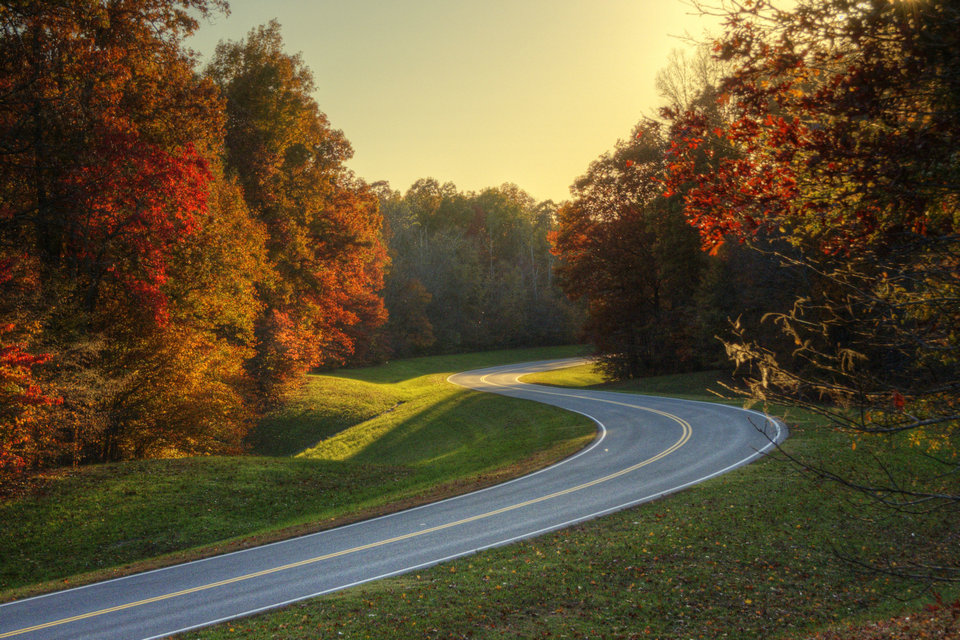National Parkway in United States


National parkways are protected scenic roadways, part of the United States National Park System. A National Parkway is a designation for a protected area in the United States. The designation is given to a scenic roadway and a protected corridor of surrounding parkland. National Parkways often connect cultural or historic sites. The U.S. National Park Service manages the parkways.
History
Parkways
The first parkways in the United States were developed in the late 19th century by landscape architects Frederick Law Olmsted and Beatrix Farrand as roads segregated for pedestrians, bicyclists, equestrians, and horse carriages, such as the Eastern Parkway and Ocean Parkway in Brooklyn, New York. The terminology “parkway” to define this type of road was coined by Calvert Vaux and Olmsted in their proposal to link city and suburban parks with “pleasure roads.” Newer roads such as the Bidwell and Lincoln Parkways in Buffalo, New York, were designed for automobiles and are broad and divided by large landscaped central medians. Parkways can be the approach to large urban parks, such as the Mystic Valley Parkway to Boston Common in Boston. Some separated express lanes from local lanes, though this was not always the case.
During the early 20th century, the meaning of the word was expanded to include controlled-access highways designed for recreational driving of automobiles with landscaping. These parkways originally provided scenic routes without at-grade intersections, very slow vehicles, or pedestrian traffic. Their success led to more development however, expanding a city’s boundaries, eventually limiting their recreational driving use. The Arroyo Seco Parkway between Downtown Los Angeles and Pasadena, California, is an example of lost pastoral aesthetics. It and others have become major commuting routes, while retaining the name parkway.
National parkways
In the 1930s, as part of the New Deal, the U.S. federal government constructed national parkways designed for recreational driving, and to commemorate historic trails and routes. As with other roads through national parks, these mostly undivided and two-lane parkways have lower speed limits, and are maintained by the National Park Service and the Federal Highway Administration jointly through the Federal Lands Transportation Program. An example is the Civilian Conservation Corps-built Blue Ridge Parkway in the Appalachian Mountains of North Carolina and Virginia. Others are: Skyline Drive in Virginia; the Natchez Trace Parkway in Mississippi, Alabama, and Tennessee; and the Colonial Parkway in eastern Virginia’s Historic Triangle area. The George Washington Memorial Parkway and the Clara Barton Parkway, running along the Potomac River near Washington, D.C., were also constructed during this era.
List
| Name | Length (mi) | Length (km) | Southern or western terminus | Northern or eastern terminus | Date | Description |
|---|---|---|---|---|---|---|
| Baltimore–Washington Parkway | 30.5 | 49.1 | US 50 / MD 201 in Cheverly, MD | Russell Street in Baltimore, MD | December 1950 | Original envisioned in Pierre Charles L’Enfant’s original layout for Washington, DC, in the 18th century |
| Blue Ridge Parkway | 469.1 | 754.9 | US 250 in Rockfish Gap, VA | US 441 in Swain County, NC | June 30, 1936 | America’s longest linear park; runs mostly along the Blue Ridge, a major mountain chain that is part of the Appalachian Mountains |
| Clara Barton Parkway | 6.8 | 10.9 | MacArthur Boulevard in Carderock, MD | Canal Road in Washington, DC | 1930 | Built as the Maryland portion of the George Washington Memorial Parkway |
| Colonial Parkway | 23.0 | 37.0 | Historic Jamestowne in Jamestown, VA | SR 1020 in Yorktown, VA | 1937 | Links the three points of Virginia’s Historic Triangle: Jamestown, Williamsburg, and Yorktown |
| Foothills Parkway | 26.8 | 43.1 | US 129 in Chilhowee, TN US 321 near Walland, TN | US 321 in Cosby, TN I-40 near Hartford, TN | February 22, 1944 | Exists in two segments with a spur connecting to US 321 / US 441 in Gatlinburg and Pigeon Forge |
| George Washington Memorial Parkway | 24.9 | 40.1 | SR 235 in Mount Vernon, VA SR 400 in Alexandria, VA | SR 400 in Alexandria, VA I-495 in Langley, VA | May 29, 1930 | Exists in two segments; the northern one also passes through Washington, DC |
| John D. Rockefeller Jr. Memorial Parkway | 27.0 | 43.5 | North boundary of Grand Teton National Park | West Thumb Geyser Basin in Yellowstone National Park | August 25, 1972 | Scenic road that connects the two national parks and named for John D. Rockefeller Jr., a conservationist and philanthropist |
| Natchez Trace Parkway | 444.0 | 714.5 | Liberty Road in Natchez, MS | SR 100 in Nashville, TN | May 8, 1938 | Commemorates the historic Old Natchez Trace and preserves sections of the original trail; also passes through Alabama |
| Rock Creek and Potomac Parkway | 2.9 | 4.7 | Lincoln Memorial Circle in the National Mall, Washington, DC | Shoreham Drive / Beach Drive in Rock Creek Park, Washington, DC | 1944 | Part of Rock Creek Park |
| Suitland Parkway | 9.1 | 14.6 | I-295 / South Capitol Street in Washington, DC | MD 4 in Forestville, MD | December 9, 1944 | Built to connect military facilities during World War II; connects to Andrews Air Force Base |